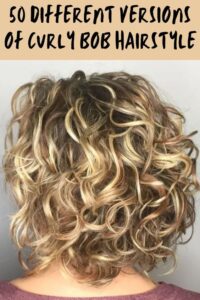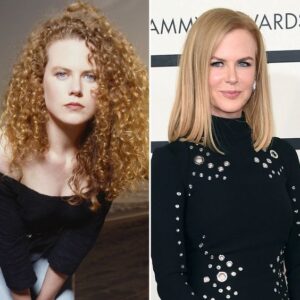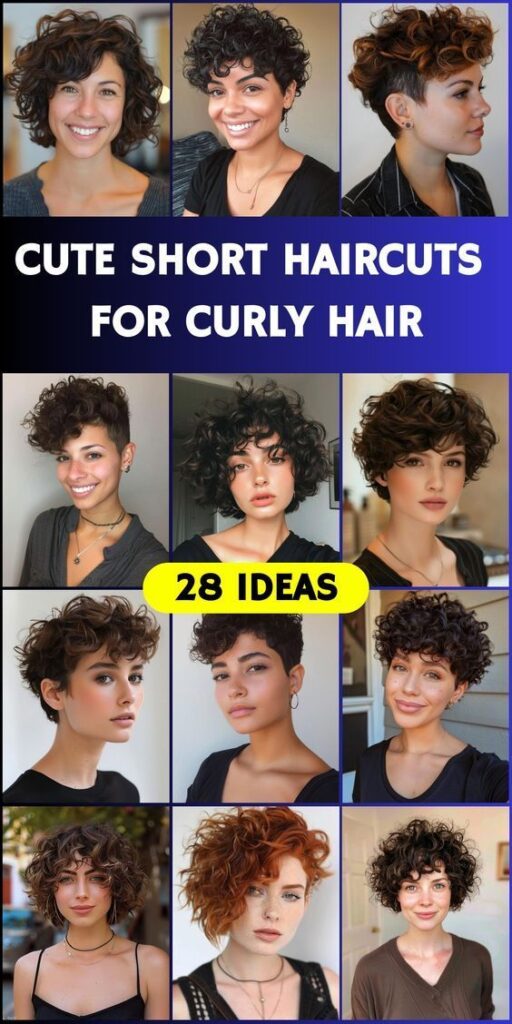
Women having curly hair can complete their look with well-known and adorable short hairstyles that take advantage of curls’ natural bounce and texture. Popular options are elegant pixie haircuts, funky bobs and choppy lob cuts that add to the curly volume and shape of hair. These types of cuts help women show off the beauty of their curls without compromising style or requiring too much maintenance.
Curly haired women’s adorable short haircuts aim at jollifying those amazing locks in a fashionable and simple way. Ranging from fun pixies to fashionable bob, such hairstyles focus on the original feel of hair with an innovative approach to brief appearance. Ideal for a swank and uncomplicated appearance, these hairstyles exhibit character through curly mane.
Trendy pixie cuts, stylish bobs, and fun lob styles are some of the most renowned and adorable short hairstyles for women with curly hair. These hairstyles emphasize natural curls and make them easy to handle. They highlight the attractiveness of curly hair in a joyful but elegant manner that is ideal for a posh and easy-going look.
Introduction
For hair rendered into spiral shapes, there are trendy short hairdos that show off curls’ natural springs and composition. Such hairstyles are fit for those desiring elegance without the pains of managing lengthy tresses.
Bringing life and manageability in curly hair, short hairstyles among them include pixie cuts, the curly bob and the lob. It is a fashion that is interestingly fresh and easy to maintain while looking stylish.
Popular Short Hairstyles for Curly Hair
Curly hair is best suited to pixie cuts which are daring, contemporary and refreshing. While highlighting your natural curls, this hairstyle remains low style and full of fun.
Curlier bobs are popular also and have a classic and flexible style. They create defined curls and make hair fuller for an elegant but casual look.
Styling Tips
In order to improve the natural wave pattern of your hair, apply a light curl defining cream or mousse. It defines, shapes and separates without adding weight to the curls.
To manage frizz, use a little bit of anti-frizz serum or oil on damp hair. It smoothens the curls making them shinier giving your short hair that neat and elegant look.

Celebrities and Influencers

Of late, the favorite hairdos are found on famous people with curly hair like Kerry Washington and Zendaya. They masterfully flaunt them even at events like COSMIC YAVO and others.They have made their name through classy and glamorous short curly haircuts that show the potentials of using natural hairs. Their hairs display different techniques of managing short strands.
Examples of short curly hair transformations are also shared by influencers on social media, together with useful tips and ideas for achieving the same looks. Fun and creative ways to style short, curly hair are shown through their posts.
Conclusion
Hairstyles with short hair for your curly hairs present a fashionable and easy way of flaunting your curls. Short hairstyles are easy to maintain and always look trendy and new.
With a short cut, you can explore your creative side while flaunting those extra amazing curls. In addition, through this trendy appearance, it also showcases our natural textures at their best.
How to Choose the Right Style
Selecting the appropriate brief hair style for the coiled locks begins by taking into account the structure of one’s face. For example, an oval face is well matched with a pixie cut while round and square face shapes are best suited for curly bobs.
Moreover, your individual way of living is another important factor. For example, if you like hassle-free hairstyles, a messy lob could work best for you while well styled pixie may suit someone who is into neatness.
Maintenance and Care
It is necessary to have a trim after every two – three weeks, this will help in sustaining their structure and avoid hair having splits. The repetition of this cycle must be done within six or seven weeks as a great move for any gusty curls.
Use products meant for curly hair as daily care products, such as moisturising shampoos and conditioners. To retain well-defined curls while keeping hair hydrated, include an application of moisturizing treatment every week.
FAQs
What are some popular short hairstyles for curly hair?
Bouncy bobs, disarrayed lobs and pixie cuts are among short wavy hairstyles. All these hairstyles serve to enhance natural curl patterns in an appealing yet manageable manner.
How can I style my short curly hair?
To boost your curl definition and keep your curls bouncing, use either a curling cream or mousse. When you want to achieve a more polished look, add some anti-frizz serum or oil in tiny amounts on wet hair.
Can short curly hairstyles be low-maintenance?
Indeed, short curly hairstyles really are usually simple to keep up with. When properly recurring techniques are used for styling and certain products combined with frequent cuts may be utilized in managing them easily.
Which celebrities have popularized short curly hairstyles?
Such stars as Kerry Washington and Zendaya sport fashionable short curls. They are ideal models of how to embrace these kinds of curls naturally.
How can I add volume to my short curly hair?
For adding more volume, use volumizing mousse or spray to the roots. Dry your hair while scrunching it to enhance lift and bounce.
Are there any special techniques for drying short curly hair?.
You can have better results if you follow this method of gently scrunching your curls into a towel or T-shirt, and avoiding frizz by using a diffuser on low heat. Also, it is possible to let your hair dry in air.
Conclusion
Short hairstyles specifically designed for women with curly hair have got an amazing blend of style and practicality. The styles range from chic pixie cuts, trendy bobs, to textured lobs emphasizing natural curls which are easy to maintain.
Wearing a short curly hairstyle enables you to flaunt your curls in style and imagination. It is an excellent method of having a trendy appearance while minimizing the complexity of caring for your hair.



